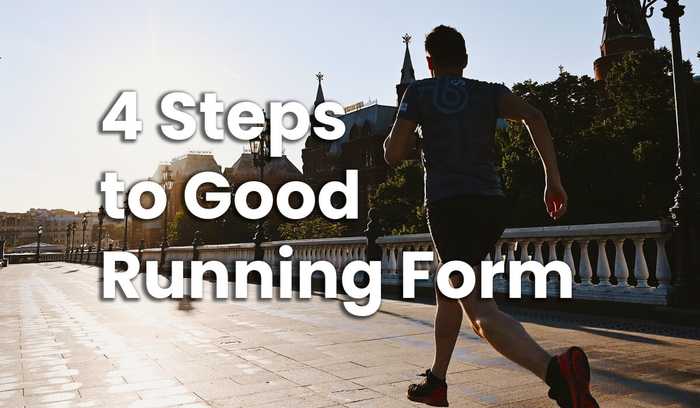4 Steps to Good Running Form

Contents
Running is one of the most popular and accessible forms of exercise, but it can also be one of the most damaging if proper form is not maintained.
Injuries such as shin splints, knee pain, and stress fractures can easily occur due to poor running form, and even the most seasoned runners can fall victim to them. By focusing on certain key elements of running form, you can not only prevent these types of injuries, but also improve your performance.
This article will take a closer look at four specific steps you can take to achieve good running form, and help you run stronger, faster, and injury-free.
Whether you’re a beginner or a seasoned runner, this guide will provide valuable insights and tips to help you improve your running technique.
Running with Proper Posture
Proper posture is the foundation of good running form and it basically means maintaining a tall, upright position while running. A direct benefit of this is more optimal breathing and efficient use of energy.
When you run with proper posture, you engage your core muscles, which helps keep your body stable and reduces the risk of injury. What is proper posture
To achieve proper posture, focus on the following key points:
- Keep your shoulders relaxed and back, avoid hunching or rounding them.
- Engage your core muscles by gently pulling your belly button towards your spine.
- Keep your head up and look forward, not down at the ground.
- Stand tall, try to keep your back straight.
Posture, like all good things, is something that needs to be practiced and maintained. It’s not something you can just do while running. It is something that you should practice during daily activities, such as sitting at your desk or standing in line at the grocery shop.
Incorporating strength training exercises that target the core and upper body – such as plank and deadlifts – will improve your posture and make it easier to maintain while running.
Good posture is not a one-size-fits-all concept. Everyone’s body is different and you may need to make slight adjustments to find your optimal posture.
A good way to start looking at this is to begin with what a poor running posture looks like. The back and neck are bent; the shoulders are high and tight, transferring tension down to the forearms and fists.
The connection between one part of the body and another becomes pronounced and obvious. You become a bit of a slouch from head to toe. As a result all the key bits fall out of sync. With this in mind, one of the best things you can do to instantly improve this is to lift your head; imagine a helium balloon is gently pulling you upwards. Runner’s World goes into great depth in the elemental parts of what makes the perfect running form.
The Correct Foot Strike
The way in which your foot strikes the ground while running can have a massive impact on your form, and additionally your risk of injury.
There are three main types of foot strikes:
- Heel strike
- Midfoot strike
- Forefoot strike
Each has its own set of pros and cons, and the best one for you will depend on your personal preference and running goals.
Heel Strike
Heel striking is the most common foot strike among runners, but it can be hard on the joints and can increase the risk of injury, especially in the knees and hips. Heel striking occurs when the heel of the foot makes contact with the ground first and the rest of the foot follows.
Midfoot Strike
Midfoot striking, on the other hand, is a more natural and efficient way of running. It reduces the impact forces on the body and allows for a smoother and more fluid running motion. Midfoot striking occurs when the foot makes contact with the ground at the midfoot and rolls forward onto the toes.
Forefoot Strike
Forefoot striking is similar to midfoot striking, but the ball of the foot makes contact with the ground first and the heel follows. Forefoot striking is less common than the other two, but it can be beneficial for runners looking to improve their speed and running economy.
How To Find a Foot Strike that Works For You
Finding the correct foot strike for you as a runner can take some experimentation and self-awareness. This can be tricky if you are a new runner, as you may still be getting comfortable with running.
There are several ways that we would recommend working out the best foot strike for you as a runner.
Get a Gait Analysis
A gait analysis is a process where a professional, such as a physical therapist, a sports medicine doctor or a running coach, analyses your running form and provides feedback.
This analysis can be done in a number of ways, including observing you running on a treadmill, analysing video footage of you running, or using technology such as pressure-sensitive matts or motion capture cameras.
The analysis will assess various aspects of your running form, including your posture, foot strike, stride length and cadence, and muscle activation patterns.
You should then be provided with feedback and recommendations on how to improve your running form. Furthermore you may also be given specific exercises or drills to help you improve your form and reduce your risk of injury.
Experiment with Different Foot Strikes
Try experimenting with different foot strikes and see how it feels. For example, try running with a midfoot strike for a few minutes and then switch to a forefoot strike. Pay attention to how your body feels and which foot strike feels more comfortable and efficient for you.
When you run, if you experience pain or discomfort in your knees, hips, or lower legs, it may be a sign that you’re heel striking. If you feel more comfortable and fluid, it may mean that you’re midfoot or forefoot striking.
Try Barefoot Running
Barefoot running, also known as minimalistic running, is a technique where runners run without the use of traditional running shoes. This may feel strange if you are not used to running barefoot, but it is a great way to find out what works best for you.
The lack of a shoe’s heel lift and cushioning forces you to land on the midfoot or forefoot. This can give you a sense of what a more natural and efficient foot strike feels like.
It is important to start slowly and gradually increase the distance and intensity of your barefoot runs. Running barefoot can put more stress on the feet and lower legs, and your body needs time to adjust.
It’s also important to pay attention to the surface you’re running on and avoid running on hard or abrasive surfaces, such as concrete or asphalt, as this can cause injury to the feet.
Finally, consider that barefoot running is not for everyone, and it’s important to consult with a healthcare professional before attempting to make the switch to barefoot running. Some people may not be able to run barefoot due to certain medical conditions or injuries.
How To Improve a Running Foot Strike
To improve your foot strike, try the following tips:
- Incorporate plyometric exercises, such as jumping jacks, into your training to improve the strength and power of your feet.
- Experiment with different types of foot strikes and find which one works best for you.
- Focus on landing on the midfoot or forefoot, rather than the heel, to reduce impact forces and reduce the risk of injury.
It’s also important to note that your foot strike may change depending on the surface you’re running on, your fatigue level, and your running goals.
Be mindful of your foot strike and make adjustments as needed. By focusing on your foot strike, you can improve your form, reduce your risk of injury, and ultimately become a more efficient and faster runner.
The Best Stride Length and Cadence
Stride length and cadence are two important elements of running form that can have a big impact on your performance.
Stride length = distance covered by one step
There is a general tendency for many runners to over-stride. Reaching out too far with your foot in front of your body. Over-striding can cause an excessive braking force, which can cause injury and slow you down. To avoid over-striding, it’s important to keep your stride short and quick, and to focus on landing on the midfoot or forefoot.
Cadence = number of steps taken per minute
A higher cadence can help you run more efficiently and reduce the risk of injury. Optimal cadence is considered to be around 180-steps per minute, but it can vary depending on the individual’s body and running goals.
To improve your stride length and cadence, try the following tips:
- Incorporate interval training into your running routine. This can help you develop a quicker and more efficient stride.
- Use a metronome or a running app that tracks cadence to help you maintain a consistent cadence.
- Focus on quick and light foot strikes. This reduces the impact forces on the body and improves your running economy.
- Practice running with a shorter stride length. This helps you become more efficient and reduce the risk of injury.
Remember that stride length and cadence can be affected by several factors:
- Fatigue
- Terrain
- Running goals
Fatigue
As you become fatigued your running form can deteriorate and you may start to over stride or have a slower cadence. This can increase the risk of injury and reduce running efficiency. It’s important to be aware of your fatigue level and make adjustments to stride length and cadence as needed to maintain proper form.
Terrain
Running on a soft or uneven surface can make it more difficult to maintain a consistent stride and cadence. This can force you to make adjustments to your running form. Running on an incline can also have an impact on your stride and cadence as your body needs to work harder to maintain balance and forward momentum.
Running Goals
If you are training for a marathon, you may focus on maintaining a slower and more consistent stride and cadence to conserve energy. On the other hand, a sprinter may focus on a shorter and quicker stride and cadence to improve speed.
It’s important to be aware of running goals and make adjustments to stride length and cadence as needed.
Relaxation
Relaxation can be easily overlooked. It is however an important aspect to building good running form.
When you’re tense or tight while running, you’re wasting energy and reducing your efficiency. Relaxation helps to conserve energy, helps you run for longer, and reduces the risk of injury.
To relax while running try the following:
- Keep your shoulders relaxed and down, avoid shrugging or tensing them up.
- Keep your arms relaxed and loose, avoid holding them too tightly or close to your body.
- Keep your hands relaxed, avoid making fists or gripping too tightly. Think of rubbing the edge of a crisp packet with your thumb and forefinger.
- Keep your face relaxed, avoid gritting your teeth or tensing your jaw.
Relaxation is something that needs to be practiced and maintained, just like proper posture. It is something that should, and can, be practiced every day.
This can be especially beneficial if training for a race, as it can help reduce pre-race nerves and stress.
Incorporating yoga, stretching and massage, and breathing exercises into your training routine can help you learn how to relax and release tension.
Yoga
Yoga is a great way to improve overall flexibility, balance, and relaxation. Yoga poses such as Child’s Pose, Downward Dog, and Cat-Cow can help to release tension in the shoulders, back, and hips, and improve overall relaxation.
Stretching
Stretching is also an important aspect of relaxation, it helps to release tension in the muscles, increase flexibility, and improve blood flow. Static stretching, where you hold a stretch for a certain amount of time, can be particularly effective in releasing tension in the body.
Massage
Massage is a popular race recovery method for runners of all levels. Post-race massage can be beneficial for a number of reasons. It can improve range of motion, reduce pain and swelling, and improve blood circulation. It is great for improving mental well-being by reducing stress and anxiety.
Massage has a number of benefits for runners. As long as you don’t have a deep tissue too close to a race, or when injured, it can be a game changer for recovery!
Breathing
Breathing exercises can also help to release tension and improve relaxation. Diaphragmatic breathing, where you focus on breathing deeply into the diaphragm, can help to release tension in the chest, shoulders, and neck. Additionally, incorporating pranayama, a yoga breathing technique, can help you learn how to control your breath and release tension in the body.



